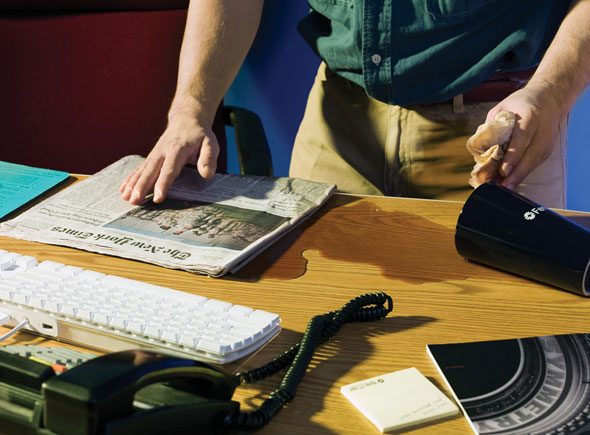Accelerator applications: Furniture finish
 |
| Photo: Reidar Hahn, Fermilab |
Who needs coasters when you have electron beams?
Particle accelerators provide clues as to how the universe began, but they also prevent coffee rings.
For about 25 years, companies around the world have been using beams of electrons from particle accelerators to make scratch- and stain-resistant furniture. The surfaces of these treated desks, shelves and tables may resemble wood. But if its nearly impossible to scuff, the furniture is likely covered in a coated, treated paper with a wood-grain design.
Its rice-paper thin, but its tougher than nails, says Ed Maguire, general manager at Energy Sciences Inc. The Massachusetts-based company is one of several that sell electron accelerators used to manufacture these durable coverings for furniture and flooring, among other things.
Before this technique was available, some companies coated furniture in plastic. It was tough and stain-resistant, Maguire says. But it was difficult to work with, expensive, and tough to print with that wood-grain pattern.
Others coat decorative paper with a polymer dissolved in water or a solvent that evaporates, leaving a solid, protective surface. However, as it dries, harmful chemicals evaporate into the atmosphere.
Most sizeable coating operations will use a thermal oxidizer, a big oven that burns off the solvent and lessens the environmental impact, says Josh Epstein, a representative from Advanced Electron Beams. But it uses a lot of energy and doesnt eliminate the harm to the environment.
In contrast, coatings made with electron beams dont contain water or solvents, and involve a negligible amount of evaporation. Instead, the electron beam promotes polymerization, the linking up of small molecules to form long, sturdy chains. This takes a small fraction of the energy used to dry conventional coatings and leaves a durable solid, which resists scratching and blocks other molecules from seeping into the fibers of the printed paper beneath.
Today with taxation against pollutants, it can actually be cheaper to use technology thats better for the environment, Maguire says.
To test the effectiveness of the coating, companies try to stain the paper with all sorts of glop, such as coffee, wine, lipstick, nail polish remover, and mustard. Mustards pretty nasty stuff, Maguire says.
But if particle accelerators can take on the search for the origins of the universe, surely they are up the challenge of a little spill.
Kathryn Grim
Click here to download the pdf version of this article.






